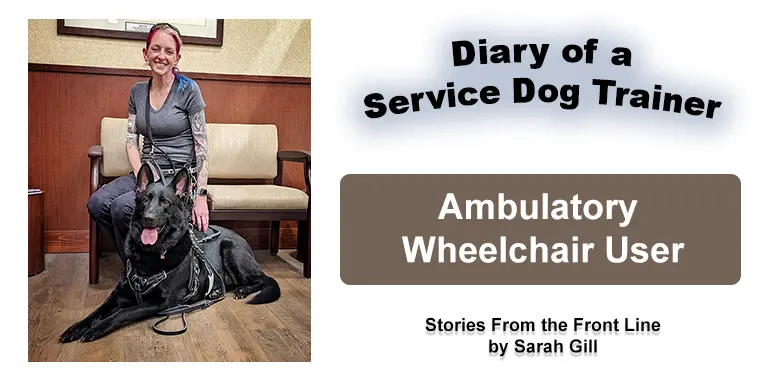
I am an ambulatory wheelchair user. A lot of people ask me what that is. An ambulatory wheelchair user is a person who uses a wheelchair regularly but does have some—usually limited—walking capabilities.
People use wheelchairs for many different reasons. I need a wheelchair due to spinal cord damage; sometimes, my legs don’t listen to what my brain tells them. I also suffer from chronic pain. Not all of my disabilities are visible, but I limp due to my injuries. My limping severity varies based on my pain level.
One of the most difficult things an ambulatory wheelchair user deals with is public judgment. The public can be cruel when judging people’s physical health. Especially when disabilities are invisible, it is common for strangers to question my need for a wheelchair. It seems to be difficult for too many not to bother other people.
My Past Experiences
In the past, I often tried to hide the fact that I am an ambulatory wheelchair user because of my profession. As a service dog trainer, I have a physically demanding job that requires coordination skills. I have those coordination skills in a wheelchair but not when walking. My profession is highly competitive. Other trainers have questioned my ability to train dogs despite never having seen me do it, simply because I do it from a wheelchair. They can’t wrap their heads around the concept that our dogs’ performance, reliability, and longevity exceed that of those judgemental competitors. I may be an ambulatory wheelchair user, but I am impressively mobile and very good at training service dogs from a wheelchair. I can do things from a wheelchair many able-bodied trainers can not do. It’s not just about physical abilities. I’m very proud of the dogs that we train.
I used to worry about what others thought of me using a wheelchair. I can’t tell you how often I tried to walk without a limp just to fit in. Being in a wheelchair would’ve held me back when I started learning my profession. I would wear combat boots and compression gear on my legs as braces to hide my injuries. The dog trainer school I was at was very discriminatory towards ambulatory wheelchair users and disabled people in general. Today, they probably couldn’t get away with it any longer. But they would have never let me attend, let alone teach the way I did from a wheelchair. I know because once I opened up about my disabilities, I lost opportunities. So, I know I read the people, school, and situation correctly.
I’m an Ambulatory Wheelchair User
It took me a long time to overcome my fears. But now, I no longer care about other people’s views of me in a wheelchair. I was able to grow past this limitation I placed on myself.
I want my clients to know I have had the same experiences as them. Because I am disabled, I can relate to my clients on a deeper level than many able-bodied trainers. I learned that my disabilities are not just a limitation. They give me a deeper insight into what service dogs truly mean. I can use them to help people, which gives me strength.
